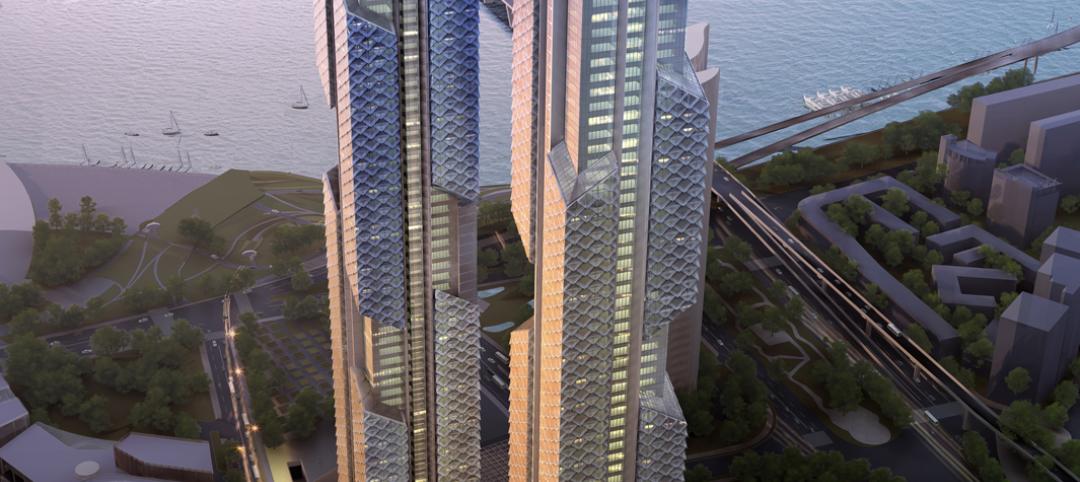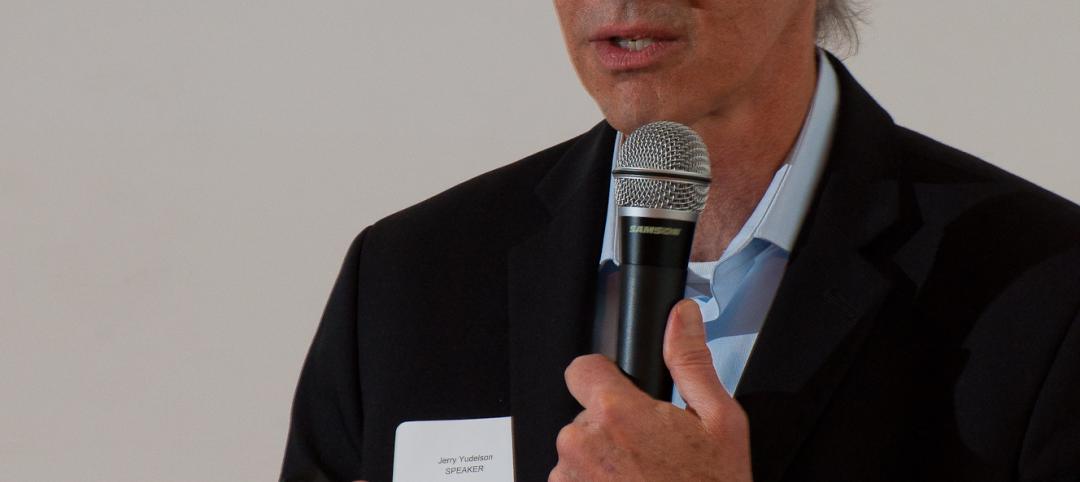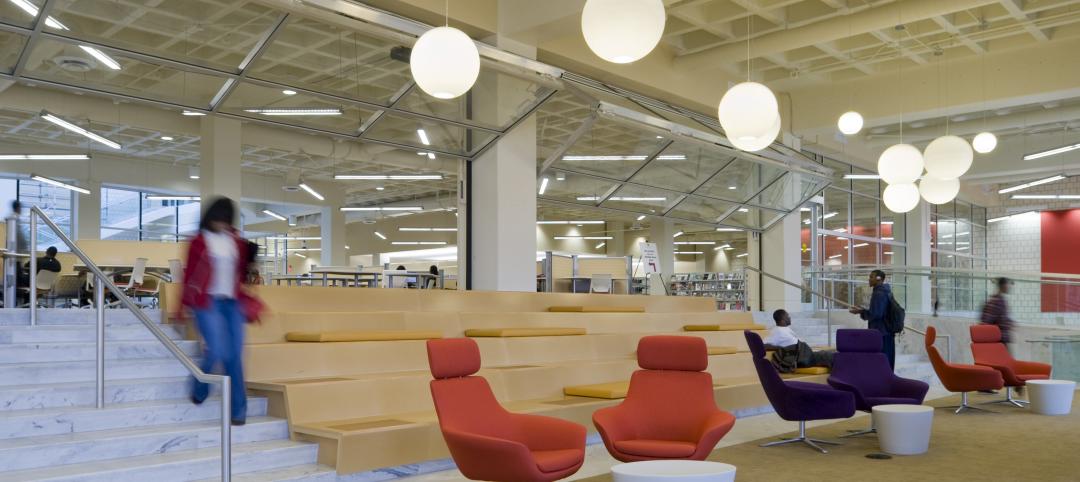While the Bird's Nest and Water Cube captured all the TV coverage during the Beijing Olympics in August, the Rem Koolhaas-designed CCTV Headquarters in Beijing—known as the “Drunken Towers” or “Big Shorts,” for its unusual shape—is certain to steal the show when it opens next year.
The Dutch architect's scheme for the $730 million, 4.8-million-sf building, which will serve as the new headquarters for China's state-run television network, essentially folds and twists the traditional skyscraper form into a parallelogram-like shape.
The result is a single loop composed of four horizontal and two vertical sections that connects CCTV's news, broadcasting, administration, and program production departments. Koolhaas's goal is to create an environment that forces everyone in the television business—creative types, producers, technicians, and administrators—to interact in hopes of producing better programming more efficiently and economically.
The novel design, with its large, nine-story base, also provides multiple social “touch points” with the public to encourage passersby to engage with the building, according to Ole Scheeren, Office for Metropolitan Architecture's partner-in-charge on the project.
Because OMA's unusual geometric scheme does not meet Chinese building code, the project structural engineering team, led by London-based Arup with the East China Architecture and Design Institute (ECADI) as local design institute of record, had to employ a performance-based design approach. As part of this process, engineers had to convince a panel of experts that the structure would not only withstand major seismic and wind events, but also hold up during construction—a significant challenge, given that the sloping vertical towers had to be connected at the top.
“The unprecedented structural design underwent the most rigorous internal and external scrutiny during a two-year span, including an expert panel review by China's Ministry of Construction,” says Rory McGowan, Arup's project director on the CCTV project.
Unlike traditional vertical high-rise construction, where the building's core serves as the primary support, Arup engineers had to utilize the building's external face as the superstructure, creating what is essentially a “continuous tube” composed of a series of steel diagonal braces, or X braces, that work in conjunction with a regular grid of columns and edge beams. This braced tube approach provides ample strength and stiffness in the towers to deliver the loads to the base, and the proper stiffness in the base to reinforce the lower tower levels and deliver loads to the foundation. It also accommodates forces from bending and twisting between the two towers, and provides the leaning towers ample stiffness during construction, allowing them to be safely constructed within tight tolerances before they were connected and propped off each other.
The distribution of the diagonal bracing is not uniform, however. Using 3D modeling software, engineers were able to make the structure as efficient as possible based on load calculations. For instance, the amount of X-bracing was doubled around heavy-loaded zones, such as the “armpits,” and halved around light-loaded zones, including the uppermost portion of the building.
“Varying the bracing density allowed us to fine-tune the structure to ensure it was not too stiff to minimize seismic loads,” says McGowan. The Arup team worked closely with OMA to express this optimized X-bracing pattern in the building's façade.
Internal steel columns extend from the foundation up to the furthest reaches of the building, providing support for the floor plates. Due to the slopping nature of the towers, the vertical columns could not extend continuously from top to bottom. To transfer the load from one series of columns to another, the team designed a system of two-story-deep transfer trusses located three-quarters of the way up the building. A similar approach was employed to support the floor plates in the cantilevered overhang.
Early on, the Building Team considered sloped vertical cores to provide a consistent floor plate layout. But finding a sloped elevator system for a building of this scale was difficult.
“We also learned that having different floor plans actually allowed more flexibility in terms of planning for studios, editing suites, and so on,” says McGowan. Therefore, the final scheme steps straight vertical cores so that they always sit within the footprint of the sloping towers.
The main towers sit on a hybrid piled raft foundation system that shares the total load coming from the superstructures between a 7½-meter-thick concrete platform, or “raft,” and a series of 1.2-meter-diameter piles that extend 52 meters into the soil. The foundation system is arranged so that the center of the raft is close to the center of load at the bottom of each tower, and no permanent tension is allowed in the piles. Limited tension in certain piles is permitted during a major seismic event.
For the nine-story base and three-story basement, a traditional raft foundation is used, with tension piles between column locations to resist uplift from water pressure acting on the deep basement. Fifteen- to 20-meter-long tension piles are arranged under the raft with additional piles under secondary cores and columns supporting large transfer trusses from the studio areas.
Related Stories
| May 24, 2012
Construction backlog declines 5.4% in the first quarter of 2012?
The nation’s nonresidential construction activity will remain soft during the summer months, with flat to declining nonresidential construction spending.
| May 23, 2012
MBI Modular Construction Campus Launched on BDCUniversity.com
White Papers, Case Studies, Industry Annual Reports, published articles and more are offered.
| May 17, 2012
EMerge Alliance forms new Campus Microgrid Technical Standards Committee
Intel leading the charge to connect multiple DC microgrids throughout commercial buildings; others invited to join effort.
| May 16, 2012
AEG releases 3D video of L.A.'s Farmers Field
The Los Angeles Convention Center footage depicts the new convention center hall spaces, including a new lobby above Pico Boulevard, pre-function space, and what will be the largest multi-purpose ballroom in Los Angeles.
| May 16, 2012
Balfour Beatty Construction taps Kiger as VP of operations
Kiger will manage current relationships and pursue other strategic clients, including select healthcare clients and strategic project pursuits in the Central Tennessee region.
| May 14, 2012
Adrian Smith + Gordon Gill Architecture design Seoul’s Dancing Dragons
Supertall two-tower complex located in Seoul’s Yongsan International Business District.
| May 9, 2012
International green building speaker to keynote Australia’s largest building systems trade show
Green building, sustainability consultant, green building book author Jerry Yudelson will be the keynote speaker at the Air-Conditioning, Refrigeration and Building Systems (ARBS) conference in Melbourne, Australia.
| May 9, 2012
Shepley Bulfinch given IIDA Design award for Woodruff Library?
The design challenges included creating an entry sequence to orient patrons and highlight services; establishing a sense of identity visible from the exterior; and providing a flexible extended-hours access for part of the learning commons.
| May 7, 2012
Best AEC Firms: MHTN Architects nine decades of dedication to Utah
This 65-person design firm has served Salt Lake City and the state of Utah for the better part of 90 years.
















